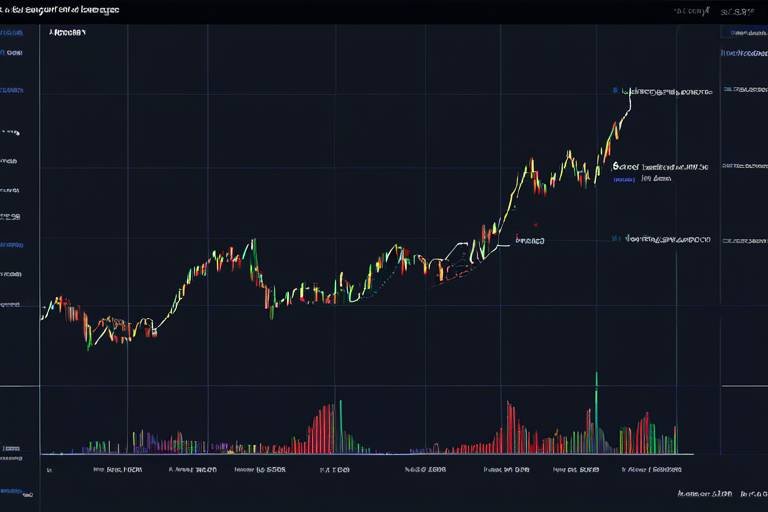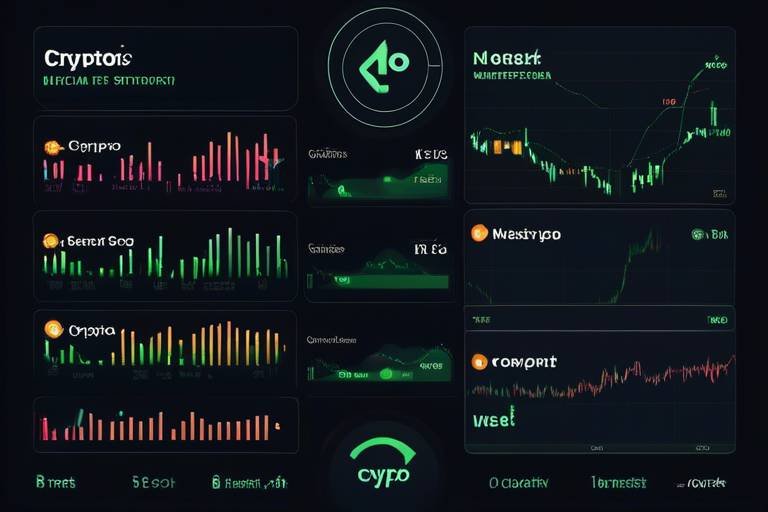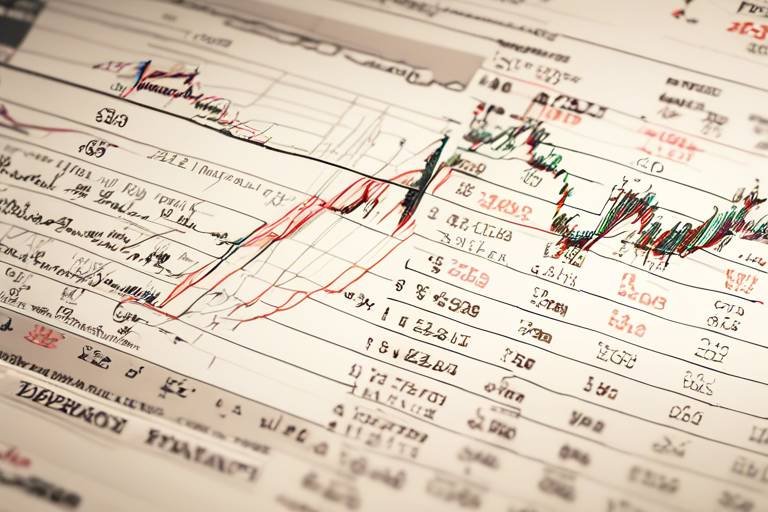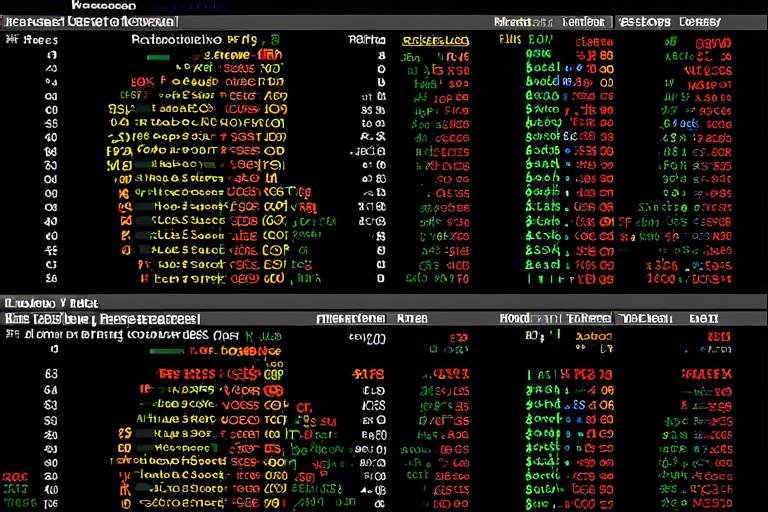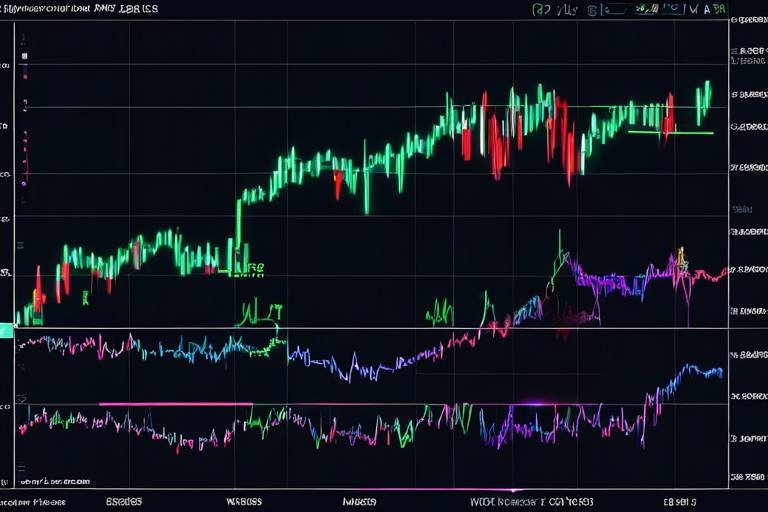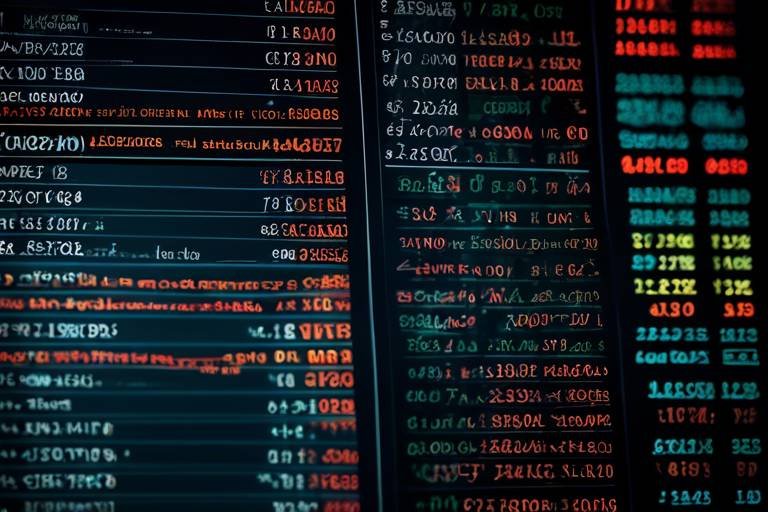Understanding the Role of Market Correlations in Crypto Trading
In the ever-evolving world of cryptocurrency, where prices can swing wildly in a matter of minutes, understanding the concept of market correlations is crucial for traders looking to navigate this volatile landscape. Market correlations refer to the degree to which two or more assets move in relation to each other. When it comes to crypto trading, these correlations can significantly influence trading strategies, risk management, and overall investment decisions. Imagine trying to steer a ship through stormy seas without knowing how the currents will affect your course; that’s what trading without understanding market correlations feels like.
By grasping the nuances of market correlations, traders can better assess their risk exposure and make informed decisions. For instance, if two cryptocurrencies are positively correlated, they tend to move in the same direction. This means that if one asset is soaring, the other is likely to follow suit. Conversely, a negative correlation indicates that when one asset rises, the other typically falls. Understanding these dynamics can help traders optimize their portfolios, allowing them to capitalize on market movements while mitigating potential losses.
Moreover, the significance of market correlations extends beyond mere observation; they can serve as a guiding light for traders. By analyzing past price movements and identifying correlation patterns, traders can predict future behavior and adjust their strategies accordingly. It’s like having a weather forecast for your investments—knowing when to expect a storm or a sunny day can make all the difference in your trading outcomes.
As we delve deeper into the intricacies of market correlations, we will explore the various types of correlations, how to analyze them, and the tools available to assist traders in making data-driven decisions. This knowledge is not just for seasoned traders; even beginners can benefit immensely from understanding how market correlations affect their trading strategies. So, buckle up as we embark on this enlightening journey through the world of market correlations in crypto trading!
Market correlations are a fundamental concept in trading that can help traders make sense of the chaotic movements in the cryptocurrency market. At its core, a correlation measures the degree to which two assets move together. This relationship can be quantified using a correlation coefficient, which ranges from -1 to +1. A coefficient close to +1 indicates a strong positive correlation, meaning the assets move in the same direction. On the other hand, a coefficient near -1 signifies a strong negative correlation, where the assets move in opposite directions. A coefficient around 0 indicates no correlation, suggesting that the assets move independently of each other.
Understanding these basics is essential for traders, as it allows them to assess risk effectively. For instance, if a trader holds multiple assets that are positively correlated, they might face amplified losses during market downturns. Conversely, incorporating negatively correlated assets can provide a hedge, reducing overall portfolio risk. This knowledge is like having an arsenal of tools at your disposal, enabling you to tackle the challenges of crypto trading with confidence.
In the realm of trading, recognizing the different types of market correlations is vital for crafting a robust trading strategy. There are three primary types of correlations: positive, negative, and no correlation. Each type has its implications for risk management and portfolio diversification.
A positive correlation occurs when two assets move in the same direction. For example, if Bitcoin rises in value, Ethereum might also see an increase. While this can amplify gains, it also increases risk during market downturns. Traders must be aware of this dynamic, as it can lead to concentrated risks in their portfolios.
In the crypto space, Bitcoin and Ethereum often exhibit strong positive correlations. Understanding these relationships can help traders predict price movements and adjust their strategies accordingly. For instance, if a trader notices that Bitcoin has been bullish, they might consider investing in Ethereum to capitalize on the upward momentum.
Given the potential risks associated with positive correlations, traders must balance their exposure to correlated assets. This requires a keen understanding of market dynamics and a willingness to adapt strategies as conditions change. It's akin to walking a tightrope; one misstep could lead to significant losses, but with the right balance, traders can navigate the high-stakes world of crypto trading successfully.
On the flip side, negative correlations occur when two assets move in opposite directions. This can be a valuable concept for risk management, as it allows traders to hedge against losses. For example, if a trader holds Bitcoin and notices that a particular altcoin tends to drop when Bitcoin rises, they might consider investing in that altcoin as a protective measure.
To effectively analyze market correlations, traders can utilize various statistical tools and historical data. This analysis helps identify trends and relationships, allowing for more strategic trading decisions. By employing correlation coefficients, traders can quantify the strength of relationships between assets, providing valuable insights into their portfolios.
Understanding how to interpret correlation coefficients is vital for traders seeking to optimize their portfolios. A strong positive correlation (e.g., +0.8) suggests that the assets move closely together, while a strong negative correlation (e.g., -0.8) indicates a tendency to move apart. By keeping an eye on these coefficients, traders can make informed decisions about which assets to hold and when to adjust their positions.
Various tools and platforms offer features for correlation analysis, making it easier for traders to monitor market dynamics. Familiarizing oneself with these tools can enhance a trader's ability to adjust their strategies based on real-time data. Utilizing advanced analytics can be the difference between a thriving portfolio and one that struggles to keep afloat in the turbulent waters of cryptocurrency trading.
- What is market correlation? Market correlation measures how two or more assets move in relation to each other, helping traders understand their risk exposure.
- How can I analyze market correlations? Traders can analyze market correlations using statistical tools, historical data, and correlation coefficients to identify trends and relationships.
- Why are positive correlations risky? Positive correlations can amplify losses during market downturns, leading to concentrated risks in a portfolio.
- What tools are available for correlation analysis? Numerous platforms offer features for correlation analysis, enabling traders to monitor market dynamics effectively.

The Basics of Market Correlations
Market correlations are like the secret language of the financial world, especially in the volatile cryptocurrency landscape. They measure the relationship between different assets, indicating how they move in relation to one another. Imagine you're at a party—some people dance together while others prefer to sway apart. In the same way, assets can show a tendency to move in sync or diverge based on various factors. Understanding these basics is crucial for traders who want to assess risk and make informed decisions in the crypto market.
At its core, market correlation helps traders gauge how different cryptocurrencies interact. For instance, if Bitcoin is on the rise, understanding whether Ethereum is likely to follow suit or move in the opposite direction can significantly influence trading strategies. This is where the concept of correlation coefficients comes into play, providing a numerical value that quantifies the strength of the relationship between assets. A coefficient close to +1 indicates a strong positive correlation, while a value close to -1 suggests a strong negative correlation. A coefficient around 0 implies no correlation at all.
Understanding these correlations is not just academic; it has real-world implications. Traders who grasp the nuances of market correlations can make better decisions regarding asset allocation and risk management. For example, if you notice a strong positive correlation between two cryptocurrencies, you might decide to limit your exposure to one of them to avoid concentrated risk. Conversely, if you identify a negative correlation, it could be an opportunity to hedge against potential losses.
To illustrate this further, consider the following table that summarizes the types of market correlations:
| Type of Correlation | Description | Implications for Traders |
|---|---|---|
| Positive Correlation | Assets move in the same direction | Increased risk during downturns |
| Negative Correlation | Assets move in opposite directions | Potential hedging opportunities |
| No Correlation | No predictable relationship | Increased diversification potential |
In summary, understanding the basics of market correlations is essential for any crypto trader looking to navigate the unpredictable waters of cryptocurrency trading. By analyzing how different assets relate to one another, traders can optimize their strategies and enhance their investment decisions. So, the next time you're evaluating your portfolio, remember that market correlations are not just numbers; they are insights that can guide you toward smarter trading choices.

Types of Market Correlations
When navigating the intricate world of crypto trading, understanding market correlations is essential. These correlations can be categorized into three main types: positive correlations, negative correlations, and no correlations. Each type plays a unique role in shaping trading strategies and managing risk, especially in the highly volatile cryptocurrency environment.
A positive correlation indicates that two assets move in the same direction. For instance, when Bitcoin's price rises, Ethereum's price tends to rise alongside it. This relationship can be beneficial during bullish markets, allowing traders to capitalize on upward trends. However, it also poses a risk during downturns, as losses can be amplified if multiple correlated assets fall simultaneously. Traders should be cautious and consider diversifying their portfolios to mitigate these risks.
On the other hand, a negative correlation occurs when two assets move in opposite directions. This can be particularly advantageous for traders looking to hedge against potential losses. For example, if Bitcoin is experiencing a decline while a stablecoin is holding its value, traders can offset some of their losses. Understanding these dynamics allows traders to create a more balanced portfolio, reducing overall risk.
Lastly, there are instances where assets exhibit no correlation at all. This means that the price movements of the assets are independent of each other. In such cases, traders can take advantage of diverse market conditions without worrying about how one asset's performance may affect another. This lack of correlation can be a strategic advantage, enabling traders to spread their investments across various assets without the risk of synchronized losses.
To further illustrate these concepts, consider the following table:
| Type of Correlation | Definition | Example |
|---|---|---|
| Positive Correlation | Assets move in the same direction | Bitcoin and Ethereum |
| Negative Correlation | Assets move in opposite directions | Bitcoin and a stablecoin |
| No Correlation | Assets move independently | Random altcoins |
In summary, recognizing the types of market correlations can significantly impact trading strategies. By understanding how different assets interact, traders can make more informed decisions, effectively manage their risks, and optimize their portfolios. Whether focusing on positive correlations to maximize gains or leveraging negative correlations for protection, the key is to remain adaptable and responsive to the ever-changing crypto landscape.

Positive Correlation Explained
A positive correlation in the world of finance, and particularly in crypto trading, refers to a scenario where two assets move in the same direction. Imagine two dancers performing a synchronized routine; when one moves left, the other does too. This relationship can be incredibly beneficial during bullish trends, as gains in one asset can lead to gains in another. However, it's essential to recognize that this synchronized movement can also pose significant risks. If the market takes a downturn, both assets may plummet together, amplifying losses for traders who haven't diversified their portfolios.
For instance, consider the relationship between Bitcoin and Ethereum. Historically, these two cryptocurrencies often exhibit a strong positive correlation. When Bitcoin’s price surges, Ethereum tends to follow suit, albeit at a slightly different pace. This correlation can be advantageous for traders who are looking to capitalize on upward trends. By understanding this relationship, traders can make more informed decisions about when to buy or sell these assets. They can also anticipate potential price movements based on the performance of the leading cryptocurrency, Bitcoin.
However, the implications of positive correlation extend beyond just predicting price movements. It’s crucial for traders to be aware of the risks associated with concentrated exposure to positively correlated assets. If a trader invests heavily in both Bitcoin and Ethereum, they might find themselves in a precarious position when the market shifts. To mitigate this risk, diversification is key. By spreading investments across assets that do not exhibit strong positive correlations, traders can create a buffer against market volatility. This strategy not only helps in managing risk but also enhances the potential for stable returns.
In summary, while positive correlations can boost profits in a thriving market, they can equally magnify risks during downturns. Traders must remain vigilant, continuously analyzing their portfolios to maintain a balanced approach. Understanding these correlations is not just about predicting the next price movement; it’s about crafting a resilient trading strategy that can withstand the unpredictable nature of the cryptocurrency landscape.

Examples of Positive Correlation
In the world of cryptocurrency trading, understanding positive correlation can be a game changer. A classic example of this phenomenon is the relationship between Bitcoin and Ethereum. Both of these cryptocurrencies often move in tandem, meaning when Bitcoin's price rises, Ethereum's price tends to follow suit, and vice versa. This correlation can be attributed to several factors, including market sentiment, investor behavior, and the overall trends in the crypto market.
For instance, during a bullish market phase, when investor confidence is high, we often see an uptick in the prices of major cryptocurrencies like Bitcoin and Ethereum. This creates a ripple effect where other altcoins also experience price increases, further solidifying the positive correlation. Traders who are aware of this relationship can leverage it to optimize their trading strategies, potentially increasing their profits.
To illustrate this point more clearly, consider the following table that highlights the price movements of Bitcoin and Ethereum over a specific period:
| Date | Bitcoin Price (USD) | Ethereum Price (USD) |
|---|---|---|
| 01/01/2023 | 40,000 | 3,000 |
| 01/02/2023 | 42,000 | 3,200 |
| 01/03/2023 | 45,000 | 3,500 |
| 01/04/2023 | 43,000 | 3,400 |
As you can see from the table, there is a clear trend where the price of Ethereum increases alongside Bitcoin's price. This kind of data reinforces the idea that positive correlations can be utilized by traders to make more informed decisions. By recognizing these patterns, traders can adjust their portfolios accordingly, either by investing in both assets or by choosing to hedge their bets based on the movements of the correlated assets.
However, it's essential to approach this concept with caution. While positive correlations can amplify gains, they can also lead to concentrated risks. If a trader has significant investments in assets that are positively correlated, a downturn in one could lead to losses in the others. Thus, understanding these correlations is key to not only maximizing profits but also managing risks effectively.

Impact on Trading Strategies
Understanding the impact of positive correlations on trading strategies is crucial for anyone navigating the tumultuous waters of the cryptocurrency market. When two assets move in tandem, traders may find themselves in a double-edged sword situation. On one hand, this amplifies potential gains when the market is bullish, but on the flip side, it can also lead to significant losses during downturns. Imagine holding multiple assets that are all tied to Bitcoin's performance; if Bitcoin takes a dive, your entire portfolio could plummet.
To effectively manage these risks, traders should consider diversifying their portfolios by including assets that are less correlated or even negatively correlated with their primary holdings. This approach can act as a buffer against market volatility, allowing traders to maintain a more stable investment strategy. For instance, while Bitcoin and Ethereum often exhibit a positive correlation, adding assets like stablecoins or even commodities can help mitigate risks.
Moreover, it's essential to constantly monitor the correlations between assets. The crypto market is notorious for its rapid shifts, and what may have been a strong positive correlation yesterday could change tomorrow. By regularly analyzing these correlations, traders can adjust their strategies accordingly, ensuring they are not overly exposed to correlated risks.
Here’s a quick breakdown of how to think about correlations when crafting your trading strategy:
- Risk Management: Always consider how correlated your assets are. A portfolio concentrated in positively correlated assets could lead to larger losses.
- Diversification: Look for opportunities to include assets that do not move in sync with your main holdings.
- Market Monitoring: Keep an eye on correlation trends; they can change quickly in the crypto world.
In summary, the impact of positive correlations on trading strategies cannot be overstated. By understanding these relationships, traders can better navigate the complexities of the crypto market, optimizing their investment decisions and ultimately enhancing their chances of success.
Q: What is a market correlation?
A: Market correlation refers to the relationship between two or more assets, indicating how they move in relation to each other. A positive correlation means they move together, while a negative correlation means they move in opposite directions.
Q: Why are correlations important in crypto trading?
A: Understanding correlations helps traders assess risk, diversify their portfolios, and make informed decisions that can lead to better investment outcomes.
Q: How can I analyze market correlations?
A: Traders can use statistical tools and historical data to analyze correlations. Correlation coefficients are commonly used to quantify the strength of relationships between assets.
Q: Can I rely solely on correlations for trading decisions?
A: While correlations are a valuable tool, they should not be the only factor in trading decisions. It's important to consider other market indicators and perform comprehensive analyses.

Negative Correlation Explained
When we talk about negative correlation, we're diving into a fascinating aspect of market dynamics, especially in the realm of crypto trading. In simple terms, negative correlation means that when one asset goes up, another asset tends to go down. It's like a see-saw: when one side rises, the other side falls. This relationship can be incredibly beneficial for traders looking to manage their risks effectively. Imagine you're on a rollercoaster, and while one ride is thrilling and full of ups, another ride offers a smooth descent. This duality can provide balance in your trading portfolio.
For instance, let's consider the relationship between Bitcoin and certain stablecoins, like Tether (USDT). When Bitcoin's price surges, the demand for stablecoins often increases as traders look to lock in profits. Conversely, when Bitcoin experiences a downturn, traders may flock back to Bitcoin from stablecoins, anticipating a price rebound. This inverse relationship can act as a safety net for traders, allowing them to hedge against potential losses. By understanding these dynamics, traders can craft strategies that leverage negative correlations to their advantage.
Moreover, negative correlation can serve as a crucial tool for diversification. By incorporating assets that move opposite to each other, traders can create a more balanced portfolio that mitigates risk. For example, if a trader holds a significant amount of Bitcoin, adding assets with a negative correlation—like certain altcoins or commodities—can cushion against market volatility. This approach is akin to having an umbrella during unpredictable weather; it may not stop the rain, but it sure keeps you dry!
To illustrate the concept further, consider the following table that highlights some common assets and their correlations:
| Asset A | Asset B | Correlation Type |
|---|---|---|
| Bitcoin | Ethereum | Positive |
| Bitcoin | Tether (USDT) | Negative |
| Gold | Stock Market | Negative |
In conclusion, understanding negative correlations is essential for traders navigating the unpredictable waters of the cryptocurrency market. By recognizing how different assets interact, traders can make more informed decisions, balancing their portfolios to shield against sudden market shifts. Just like in life, where opposites can often complement each other, the same principle applies to trading strategies. So, the next time you're analyzing your crypto assets, consider how negative correlations might provide that crucial safety net!
- What is a negative correlation? A negative correlation occurs when two assets move in opposite directions—when one goes up, the other typically goes down.
- How can negative correlation help in trading? It can help traders hedge against losses, allowing for a more balanced and diversified portfolio.
- Can you give an example of assets with negative correlation? Bitcoin and Tether (USDT) often show negative correlation, as traders shift between them based on market conditions.
- Why is understanding correlations important? Recognizing correlations helps traders make informed decisions, manage risk, and optimize their trading strategies.

Analyzing Market Correlations
In the fast-paced world of cryptocurrency trading, understanding market correlations is not just advantageous; it's essential. Traders must analyze how different cryptocurrencies interact with one another to make informed decisions that can significantly impact their portfolios. By delving into market correlations, traders can uncover hidden patterns that may dictate price movements, allowing them to navigate the volatile crypto landscape with greater confidence.
One of the primary methods for analyzing market correlations is through the use of statistical tools. These tools help traders quantify the relationships between various assets, providing a clearer picture of how they move in relation to one another. For instance, by examining historical price data, traders can identify trends that indicate whether two cryptocurrencies are positively or negatively correlated. This analysis is not merely academic; it has real implications for trading strategies and risk management.
To facilitate this process, traders often rely on correlation coefficients. These coefficients range from -1 to +1, with -1 indicating a perfect negative correlation, 0 indicating no correlation, and +1 indicating a perfect positive correlation. Understanding how to interpret these coefficients is crucial for traders aiming to optimize their portfolios. For example, if a trader discovers that Bitcoin and Ethereum have a correlation coefficient of +0.85, they can infer that these two assets tend to move in the same direction. Conversely, a coefficient of -0.75 between Bitcoin and a lesser-known altcoin suggests that when Bitcoin rises, the altcoin tends to fall, providing a potential hedge against losses.
Moreover, there are various tools and platforms available that offer correlation analysis features, enhancing a trader's ability to monitor and adjust their strategies based on market dynamics. Platforms like TradingView and CoinMetrics provide valuable insights through visual representations of correlation data, making it easier for traders to identify relationships at a glance. By leveraging these tools, traders can stay ahead of the curve, adapting their strategies to maximize gains and minimize risks.
In conclusion, analyzing market correlations is a vital component of successful crypto trading. By employing statistical tools and understanding correlation coefficients, traders can make more strategic decisions, ultimately leading to better investment outcomes. The insights gained from this analysis can help traders navigate the unpredictable waters of the cryptocurrency market, turning potential pitfalls into opportunities for growth.
- What is a correlation coefficient? A correlation coefficient is a statistical measure that indicates the strength and direction of a relationship between two assets.
- Why are market correlations important in crypto trading? Understanding market correlations helps traders manage risk and make informed investment decisions, especially in a volatile market.
- How can I analyze market correlations? Traders can analyze market correlations using statistical tools, historical data, and correlation coefficients to identify trends and relationships.
- What tools can I use for correlation analysis? Platforms like TradingView, CoinMetrics, and various trading software offer features for correlation analysis, helping traders visualize relationships between assets.

Correlation Coefficients
Correlation coefficients are essential tools in the world of trading, especially in the volatile realm of cryptocurrencies. They provide a quantitative measure of the relationship between two assets, indicating how closely their prices move in relation to one another. The value of a correlation coefficient ranges from -1 to +1, where:
- +1 signifies a perfect positive correlation, meaning both assets move in the same direction.
- -1 indicates a perfect negative correlation, where one asset moves in the opposite direction of the other.
- 0 suggests no correlation, implying that the movements of the assets are entirely independent.
Understanding these coefficients is vital for traders looking to optimize their portfolios. For instance, if a trader notices that Bitcoin (BTC) and Ethereum (ETH) have a high positive correlation, they might decide to invest in both to capitalize on potential gains. However, this could also lead to increased risk, particularly during market downturns, as both assets may decline in value simultaneously.
On the other hand, if a trader identifies a negative correlation between Bitcoin and a lesser-known altcoin, they might consider this altcoin as a hedge against potential losses in their Bitcoin holdings. This strategy can provide a cushion during volatile market conditions, allowing traders to manage risk more effectively.
To illustrate the importance of correlation coefficients, consider the following table that summarizes different correlation scenarios:
| Correlation Coefficient | Relationship Type | Example Scenario |
|---|---|---|
| +1 | Perfect Positive | BTC and ETH rising together during a bull market. |
| -1 | Perfect Negative | BTC rises while a stablecoin like USDT remains unchanged. |
| 0 | No Correlation | BTC price changes do not affect the price of a niche altcoin. |
In summary, correlation coefficients serve as a compass for traders navigating the tumultuous waters of crypto trading. By understanding these coefficients, traders can make informed decisions, balancing their portfolios to maximize gains while minimizing risks. As the crypto landscape continues to evolve, staying attuned to these relationships will be crucial for anyone looking to succeed in this dynamic market.
Q1: How can I calculate the correlation coefficient?
A correlation coefficient can be calculated using statistical software or even Excel. The formula involves the covariance of the two assets divided by the product of their standard deviations. However, many online platforms provide this data readily, making it easier for traders.
Q2: What does a correlation coefficient of 0.5 mean?
A correlation coefficient of 0.5 indicates a moderate positive correlation. This suggests that the two assets tend to move in the same direction but not perfectly. Traders may consider this when diversifying their portfolios.
Q3: Can correlation coefficients change over time?
Yes, correlation coefficients can fluctuate based on market conditions, economic factors, and investor sentiment. It's essential for traders to regularly analyze these coefficients to stay updated on asset relationships.

Tools for Correlation Analysis
In the fast-paced world of cryptocurrency trading, having the right tools at your disposal is crucial for making informed decisions. Correlation analysis is no exception. Various platforms and software can help traders assess market correlations effectively, allowing them to gauge the relationships between different cryptocurrencies and other assets. By utilizing these tools, traders can enhance their strategies and potentially increase their profitability.
One of the most popular tools for correlation analysis is the use of statistical software. Programs like R and Python offer libraries specifically designed for financial analysis, including correlation matrices. These tools allow traders to input historical price data and compute correlation coefficients, providing a clear picture of how assets move in relation to one another. For those who may not be tech-savvy, there are also user-friendly platforms available that simplify the process.
Another essential tool is the trading platform itself. Many trading platforms now come equipped with built-in analysis features that allow users to visualize correlations between assets. For example, platforms like TradingView or Coinigy provide interactive charts that can display correlation coefficients over time, helping traders spot trends and make timely decisions. These platforms often offer customizable settings, enabling traders to focus on the specific assets they are interested in.
Additionally, correlation heatmaps are invaluable for visual learners. These heatmaps use color coding to represent the strength of correlations between various assets, making it easier to identify positive and negative relationships at a glance. Traders can quickly assess which assets are moving together and which are diverging, allowing for more strategic portfolio management.
Moreover, financial news aggregators and analytics websites often provide correlation data along with market news, which can be a game-changer. Websites like CoinMarketCap and CoinGecko not only track cryptocurrency prices but also offer insights into market trends and correlations. By staying updated with the latest news and analysis, traders can make more informed decisions based on current market conditions.
In summary, leveraging the right tools for correlation analysis can significantly enhance a trader's ability to navigate the volatile cryptocurrency market. By understanding the relationships between different assets, traders can better manage risk and optimize their investment strategies. So, whether you’re a seasoned trader or just starting, investing time in learning these tools can pay off in the long run.
- What is correlation analysis in crypto trading? Correlation analysis measures the relationship between different cryptocurrencies or assets, indicating how they move in relation to one another.
- Why is correlation important for traders? Understanding correlations helps traders manage risk and make informed decisions, especially in a volatile market like cryptocurrency.
- Can I analyze correlations without advanced software? Yes, many trading platforms and online tools provide user-friendly options for correlation analysis without requiring advanced technical skills.
- What tools can I use for correlation analysis? Popular tools include statistical software like R and Python, trading platforms such as TradingView, and financial news aggregators like CoinMarketCap.
Frequently Asked Questions
- What are market correlations in crypto trading?
Market correlations refer to the relationship between different cryptocurrencies and how they move in relation to one another. Understanding these correlations helps traders assess risk and make more informed trading decisions.
- Why are positive correlations important for traders?
Positive correlations indicate that two assets move in the same direction. This can amplify gains but also increase risks during downturns. Traders need to be aware of these correlations to avoid concentrated risks in their portfolios.
- Can you give an example of positive correlation in crypto?
Sure! A common example is Bitcoin and Ethereum, which often move together in price trends. By recognizing this relationship, traders can better predict price movements and adjust their strategies accordingly.
- What is a negative correlation, and how can it help traders?
A negative correlation occurs when two assets move in opposite directions. This can serve as a hedge against losses, providing a safety net for traders in volatile markets. It's essential for effective risk management.
- How can I analyze market correlations?
Traders can analyze market correlations using statistical tools and historical data. These analyses help identify trends and relationships, enabling more strategic trading decisions in the dynamic crypto landscape.
- What are correlation coefficients?
Correlation coefficients quantify the strength of the relationship between assets. Understanding these coefficients is crucial for traders looking to optimize their portfolios and make informed trading choices.
- What tools can I use for correlation analysis?
There are various tools and platforms available for correlation analysis, including trading software and online analytics tools. Familiarizing yourself with these can significantly enhance your ability to monitor market dynamics and adjust your trading strategies.








